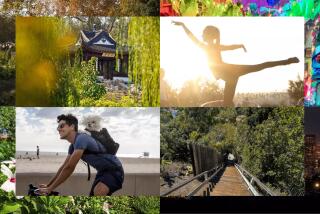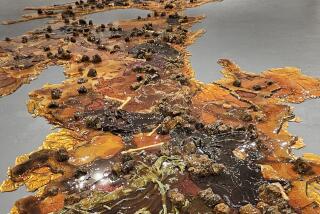The Natural and the Unnatural
Through the eyes of Laurie Brown, Anthony Hernandez and Warren Neidich, the landscape of Southern California isn’t about idyllic vistas. These photographers’ focus is gritty urbanism, on display in solo exhibitions opening Sunday at the Laguna Art Museum.
Brown photographs suburban fringe with panoramic views of graded hillsides. Hernandez captures signs of humanity in empty urban ruins. And Neidich chronicles a blurred line between the slick world of the media and reality.
Brown’s “Recent Terrains” opens with a dreamlike, black-and-white vista of a low hill above a dark, furrowed plain. Organized by Tyler Stallings, curator of exhibitions at the Laguna Art Museum, Brown’s collection of landscapes in Orange and Riverside counties shows the fronts of cookie-cutter home developments and the retreating agrarian scenery.
“It’s the borderline between the natural and man-made landscape,” Brown said.
Brown has photographed the landscape of Southern California since she graduated from Cal State Fullerton in 1976. The Newport Beach artist spent years hiking and exploring the outdoors with her family.
“I’m very drawn to looking at the way the earth curves, the natural monuments of the land, and the marks we make--evidence of man’s presence--on the landscape,” Brown said. “I’m viewing our time and place and location in terms of where we are in history.”
Her gelatin silver prints, up to 50 inches wide, are black and white. They are excerpts from her book, “Recent Terrains: Terraforming the American West,” published last year. Her photos start with vistas of graded lands and cul-de-sacs under construction and moves to rows of finished houses set against the landscape or close-ups of just rooftops.
The images say, “‘Here we are on the edge of the West ... the idealized frontier of wilderness, and it’s basically been entirely built up,”’ Brown said. The changes evoke a tension the artist sees from a distance.
“I think I’m fascinated by our complex love-hate relationship with the landscape, because I’m repelled by all the construction and also attracted to the beauty of the pattern of the houses and how they’re just spread out across the land in these little crowded, urban residential areas.”
Brown uses black and white to set the tone.
“My work is about the quiet,” Brown said. “It’s an attempt to search for a calm and order, to get a deeper meaning beyond the day-to-day glare and noise of our culture.”
While Brown explores the suburban landscape, Hernandez dives into an urban world of empty dwellings filled with old clothes, debris, broken furniture, mattresses and discarded construction materials.
Seventeen of his large-format, color photographs were taken in Oakland as part of an artist-in-residence program with Capp Street Project, presented by the CCAC Institute at the California College of Arts and Crafts. The traveling exhibition is curated by Ralph Rugoff, institute director.
The Los Angeles-based Hernandez, unfamiliar with the Oakland area, spent four months learning about the city’s underbelly from people on the street. He was told to check out the now-defunct Montgomery Ward, which was scheduled for demolition. His exhibition opens with his largest image--a 47-inch photograph of what he found as he sneaked inside the abandoned department store.
“I hooked up with people who let me into these empty buildings that were going to be transformed in some way--whether it was going to be demolished [because of] earthquake damage or was closed down and abandoned,” Hernandez said.
Among the buildings are a former Bank of America site and a closed U.S. Army base with apartment complexes that will be torn down. The closets of one funky hotel were the subject of three of his photographs. In one closet, someone drew a nude young man with his shorts pulled down to his knees.
“There were these closets that were the most interesting thing that I saw,” said Hernandez, who had to sign a waiver and wear a mask and protective clothing to enter.
He began photographing haunting interiors while on a fellowship at the American Academy and produced the series “Pictures from Rome” in 1999. He uncovered some urban ruins where war refugees had taken shelter.
“In Rome, there are a lot of empty buildings that squatters just take over, which would never happen in L.A.,” Hernandez said. “In the United States, the buildings would just get torn down.”
Since then, people have continued to inform him of buildings he should explore. Back in the United States, Hernandez found a new set of ruins.
“Most people don’t want to embrace these spaces, and they don’t want to be there. But in all these ordinary places that no one cares about, there’s something human to look at if you care to look at it.”
Neidich, another well-traveled photographer, embarked on a trek across America from his residence in New York City to see what Jack Kerouac’s main character Sal Paradise saw in the novel “On the Road.” His personal interest in the beat generation writers led him to San Francisco and Los Angeles.
“Kerouac’s book was written about 50 years ago, so I wanted to see how America had changed in those years,” Neidich said.
His 1995 trip landed him in the middle of Camp O.J., a media encampment extending two blocks near the County Courthouse in downtown Los Angeles.
“It was a surreal experience,” Neidich said. “How we experience America has changed so dramatically. What was once the experience of individuals has now turned into a huge apparatus of corporate America.”
In his “Camp O.J. Installation,” Neidich paints black-and-white stripes on the gallery walls on which he hangs 15 of his large color photographs. The stripes make the walls seem to move. “So it’s like a fun house,” Neidich said.
His show is traveling from the Bayly Art Museum in Charlottesville, Va.
Neidich’s “Back Stage Night No. 2” is a picture of reporters brightly lit in a nighttime scene. “Grand Stage Shot No. 3” appears to distort reality so that it’s difficult to tell whether the scene is staged.
Some images resemble slick, backstage pictures of a rock concert.
“‘Grand Stage Shot No. 3’ is a photograph about the loss of boundaries,” Neidich said. The greenish-tinted image shows a reporter in the background wearing a red coat next to a microphone and stand.
“It looks like she could be singing a song on ‘Ally McBeal,”’ Neidich said.
The psychedelic colors in Neidich’s photographs are part of the effect. He uses a method called cross-processing that is most common in fashion photography. The technique produces odd, distorted colors which suit the subject matter, he said.
“In my opinion, coverage of the O.J. trial turned news into entertainment news,” Neidich said. “That was an important moment, because it made news information seem more like fiction with its own logos and cast of characters, and the newscasters were more like movie stars.”
*
Three solo photographic exhibitions feature Laurie Brown in “Recent Terrains,” Anthony Hernandez in “Pictures for Oakland” and Warren Neidich in “The Camp O.J. Installation.” Laguna Art Museum, 307 Cliff Drive, Laguna Beach. Opens Sunday. Museum hours: Daily, 11 a.m.-5 p.m. Closed Wednesday. $4 to $5. Free Tuesdays. Ends Oct. 7. (949) 494-8971.
More to Read
The biggest entertainment stories
Get our big stories about Hollywood, film, television, music, arts, culture and more right in your inbox as soon as they publish.
You may occasionally receive promotional content from the Los Angeles Times.










